We’re in Calgary working with Truck Gallery’s CAMPER Urban Discovery project, doing a residency based on our “…and then the city…” (ATTC) research. Developed after a six-month community research project back in Windsor called, Save the City, ATTC was initially realized as two billboards in Windsor and an accompanying publication that looked at the cyclical nature of city narratives — the things that we’re told and the things we tell ourselves about the places we live.
We’re here for 10 days working to develop a practice that can begin to unfold the complexities of Calgary and how the people, architecture, infrastructure, planning policies, and connections shape this city. We’re interested in the largest sense in understanding locality in both its reading and practice, and Calgary is already proving to be a wonderfully curious research site.
If you’re in Calgary, you can catch us at CAMPER by taking a look at our schedule, and if you’re away, you can expect posts everyday on our process.
We land in Calgary after a 4 hour flight away from the hottest city in the country and rain greets us shortly after.
We’re staying in Chinatown, great food is everywhere.
We have about 500 of these in varying colours… we want to hear about a lot of different narratives for Calgary.
Day 1 of our project finds us getting our bearings at CAMPER, parked at 222 8 Avenue SW, and setting out on an algorithmic walk to explore the city at random.
Along with getting better acquainted with the city, we’re also interested in looking at shortcuts of all kinds — physical movements through space for the sake of efficiencies and shortcuts to different outcomes for the city. Shortcuts become small sites of resistance and provide a much deeper look at how a city can shift towards alternative narratives (and ultimately experiences).
CAMPER is going to be our studio lab for the next week and a bit.
Before we set out on our walk, we need to figure out how we’ll move. We’ve done a number of algorithmic walks (and subway rides) before, and most-often we’re pulling from a long set of instructions. This time, we wanted the decisions to be simpler, so Michelle made one of those fortune tellers that you might recall from elementary school recess.
Under each flap was a simple instruction like, turn right and walk 3 blocks.
The completed fortune teller.
All of the possibilities.
We headed out with Todd, TRUCK’s summer student, and Randy, TRUCK’s Programming Coordinator.
And, we planned to use Twitter to record some level of observations at each location.
We used the location service and a photo along with some brief text to note the use or feelings that each location tried to impose and possible shortcuts around these impositions. We used tags like #r2 to denote a step like turn right and walk two blocks.
Our first randomly selected direction sends us to this parket / terrace, raised above street level like so much of Calgary, surrounded by concrete and walls, and manicured.
We encounter what we thought was an obvious shortcut — hacking a private garden, but ultimately, this gentlemen was employed by BMO to tidy up the space.
The parket / terrace was strange in its above street-level structures, benches, and small signs reminding us that despite its appearance, you are in a private-owned and controlled space.
Instant shortcuts towards misuse of the space would be supplied by this power source. The space itself is constructed to deter much physical misuse (read skateboarding), so we imagined lots of fun that could be more temporal.
Twitter post #1: BMO-owned raised concrete park offers free power for misuse with private property signs, mixed messages.
Our next step landed us at a high-end shopping space and we immediately saw the piece of plywood as a shortcut to the experience of this place. Again, we’re thinking about shortcuts in the widest sense of tactical resistance to existing spatial capacities.
Twitter #2: Raggedy plywood demonstrates a shortcut to reality in a high class shopping district.
Michelle and Josh at work on a busy Calgary street.
We continue walking and exploring, noting that we have to revisit their +15 infrastructure.
Further down, massive concrete underpasses note a history of tags and graffiti, though we’re uncertain of how recently it’s been repainted.
Deterrents?
The only remaining urban note, certainly officially sanctioned would be a fun starting point for other communication.
More tags at a construction site, at the edge of the part of downtown that the city cares about.
Parking lots line so much of Calgary’s downtown — though their signs give me a lot of ideas.
And where they aren’t parking lots, there are parking structures with lots of blank surfaces.
Twitter #3: long forgotten corner, patchwork repairs, outdoor projection waiting to happen. Space says move, we say stay.
More signs, we have to adopt these for something.
Another decision sends us back to the edge of valuable real estate. Gardens and advertisements reappear.
Twitter #4: welcome back to valuable real estate, surrounded by street level commercial property & ads, no immediate shortcuts.
Strange fence overhangs… memories of old infrastructural decisions.
Another concrete park, bizarre.
The view from above, so much man made material closing in on a large rock.
Uncertain about Century Park’s role beyond moving people through space — or rather, “passive recreation.”
Twitter #5: concrete water park, sign specifies no game playing, an easy shortcut is setting up a chess board.
You exit surrounded by even more concrete.
Small gestures of resistance and city-shaping are evident, though far apart.
Further on our journey, signs of new investment, which offers an interesting observation — a part of town that has long been the landing point at the far end of the C-Train will now become another stop on a longer line.
Streets await more work, more concrete, more movement. Perhaps a result of Calgary’s winters, there are few places to actually stay for any period of time in Calgary.
Twitter #6: investment to move people thru faster. Neighbourhood as landing area for c-train no more. People dash, slow needed.
Signs of curious infrastructure and a moment to imagine our cross-border portals.
Footsteps like this are common, which makes me curious about a time when people were uncertain of walking over these grates.
Signs of reuse. These textual references provide aesthetic narratives of time.
Around the corner, another example of common architectural decisions — any greens pace starts above streetlevel, to serve as decoration for a parking lot, while retail space is pushed far back under an overhang. Again, it’s very possible that we’re missing the point, not being here in the winter and all, but what it really seems to indicate is narrative written by the people who have no need for street level everyday experience. It would seem to be an immediate shortcut to plant at the street level in the numerous vacant planters.
Twitter #7: life set back and above ground. Green edges for parking lot, raised sidewalk for buried retail. Plant on yer own.
We’ve missed the Calgary Stampede by about a week, it would seem that this is the general sentiment that we encounter.
Onto our next step, it brings us to one of the few rationally planned corners that we encounter in our walk. Street level access to green space. Physical shortcuts are already designed, the city might be listening.
However, it reads as a missed opportunity as the grass remains underutilized for anything other than decoration. The city insists that we keep moving, using the sidewalks only, please.
Twitter #8: possibly the only corner in the city no cordoned off feels new, learning from mistakes? Shortcuts premade, soccer?
High-tech infrastructure exists for parking, yet the C-train’s LED screens don’t denote any stop.
Curious infrastructural hopscotch. More play.
A building that tells you it’s from the future, but you shouldn’t go near it.
Further along, we take another look at +15, we note it as another pre-existing and municipally sanctioned shortcut, but without the fun resistant qualities of user-designed efforts possible elsewhere.
Twitter #9: plus15 walking path crosses the city, shortcuts for pedestrians leery of street interaction. City starts above.
Nearing the end of our walk we see a prime example of Calgarian architecture — huge glass walls, founded on concrete and raised entrances create narratives of refusal.
History becomes visible occasionally, though a strange cartoon of itself emerges. Tolerance for anything that really happened before the 50s seems to be low.
And we end looking at an attempt for a part of the city’s past to literally plug into its current form.
Twitter #10: intersections of history and modern urbanism. Shortcuts through time, but buried in the now.
The narratives we started to render by examining the spatial realities of Calgary during our walk were based on resistance — shortcuts that we imagined or observed, some quite impossible, others already unfolding. Signs of resistance are perhaps truer markers the lived experience in a city. The distance between the lived experience and the experience we’re told about as visitors (or as citizens) of a given city is where we’re locating this research.
In using the phrasing of “…and then the city…” as a framework for thinking through the peculiarities that go into forming a place and our experience of it, we can generate a dialogue that is at once intimately nuanced and incredibly broad. Moving forward with our research over the coming days, we’re interested to understand how Calgarians think about their city, and ultimately what narratives their telling themselves about this place.
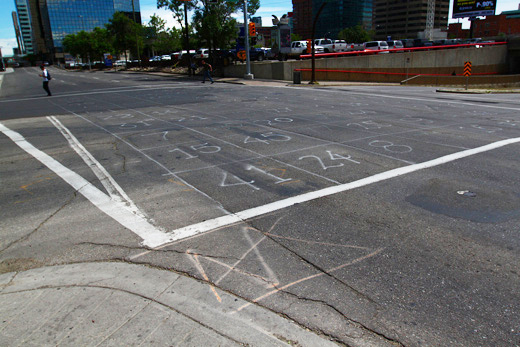
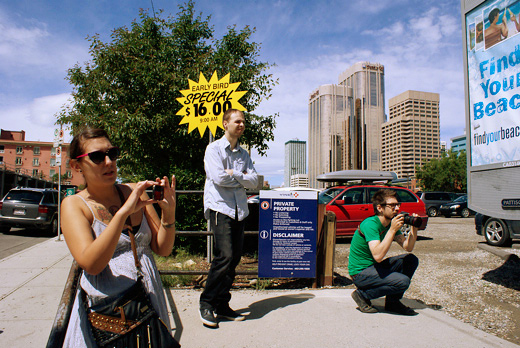


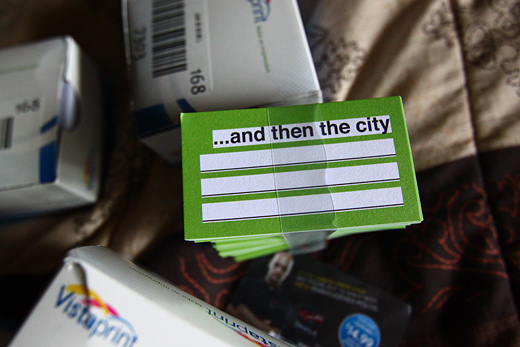
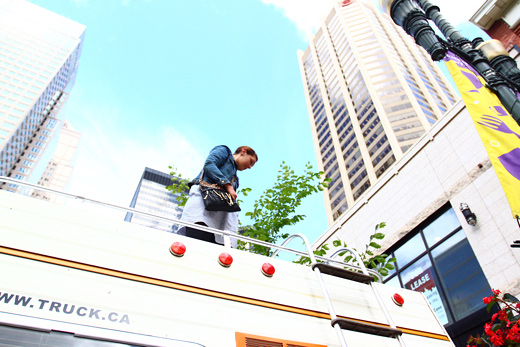
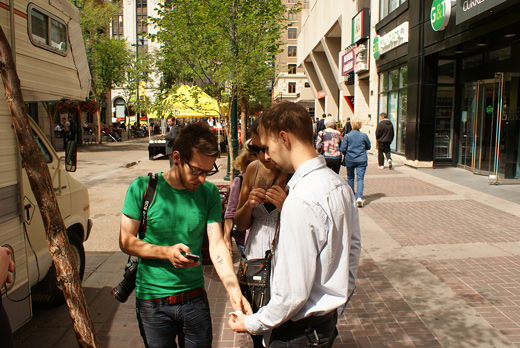


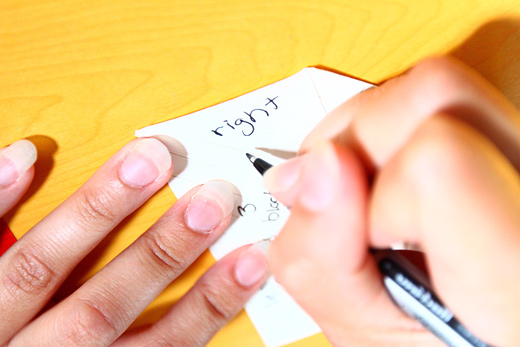



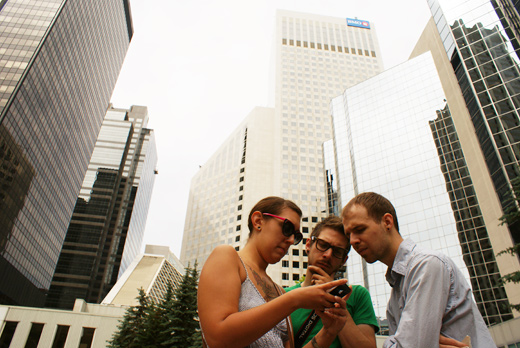


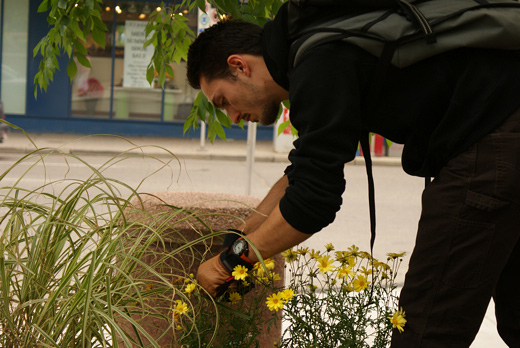


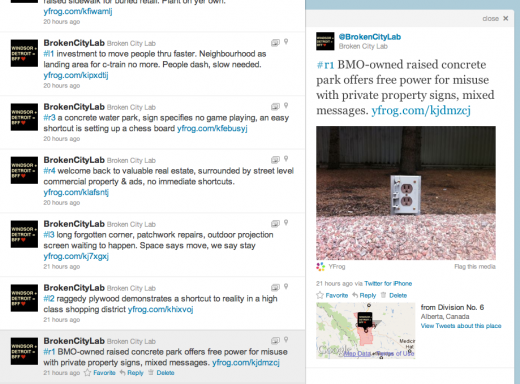
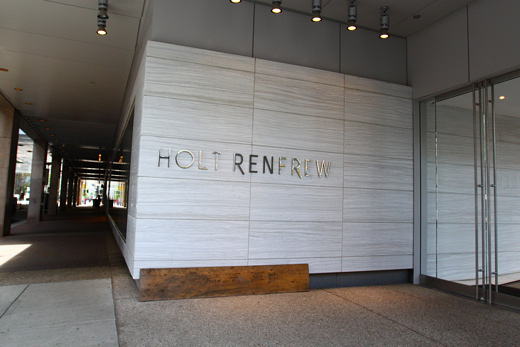
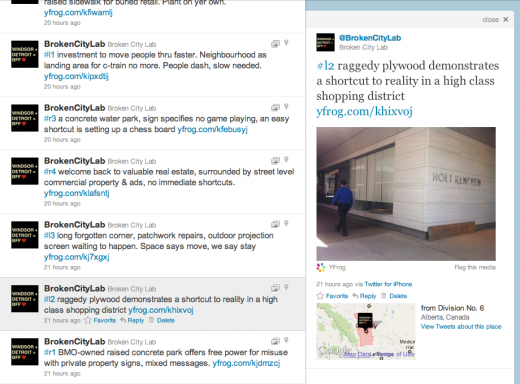
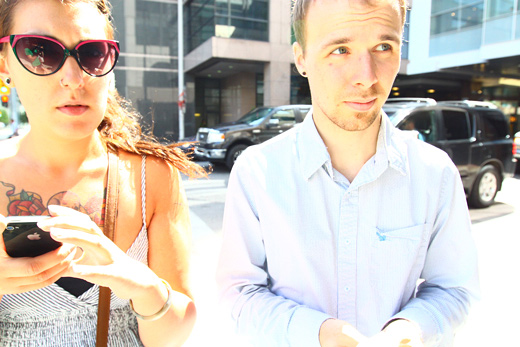







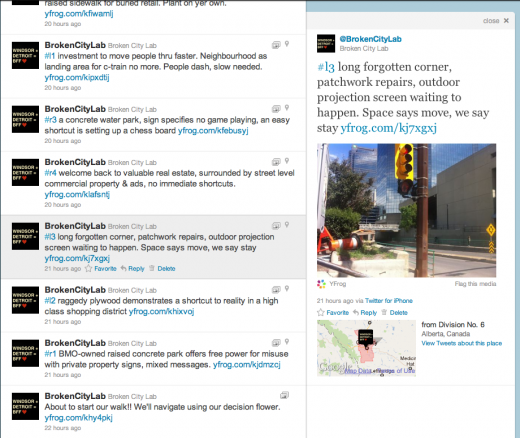


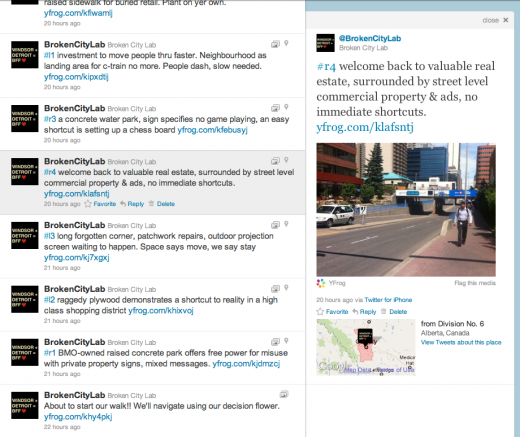




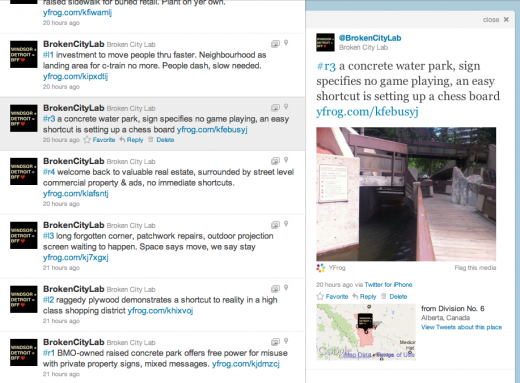
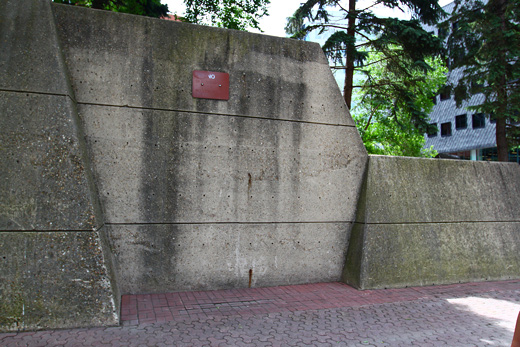

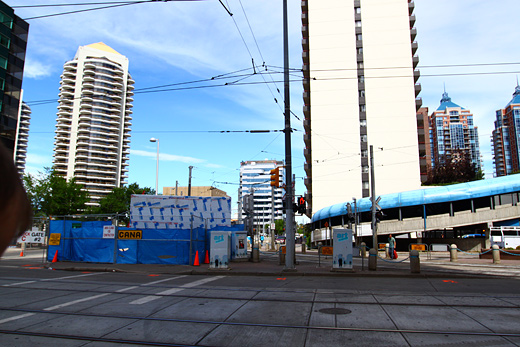

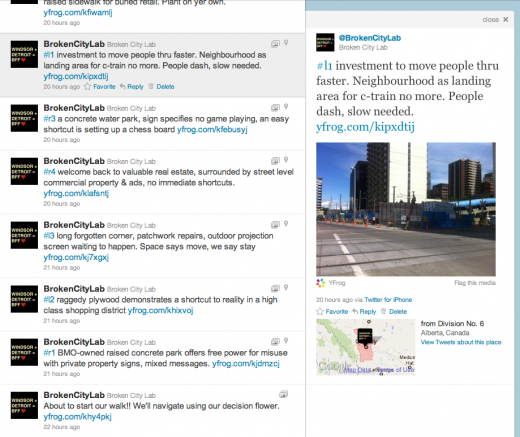
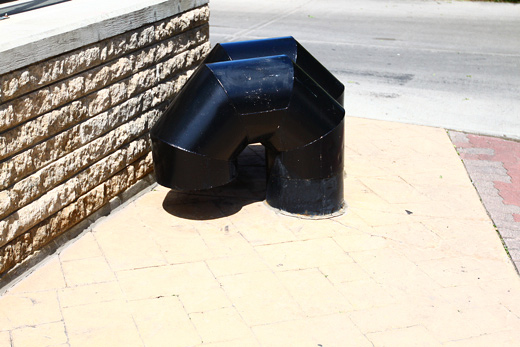

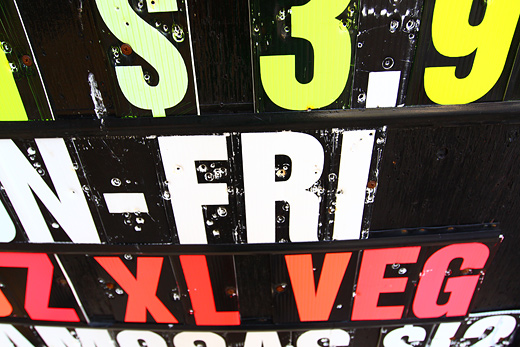

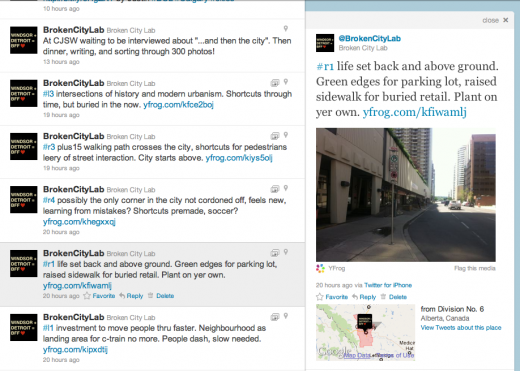


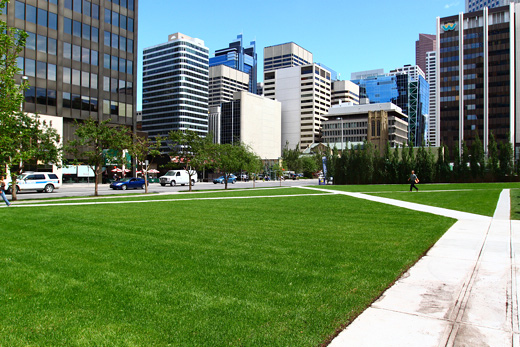
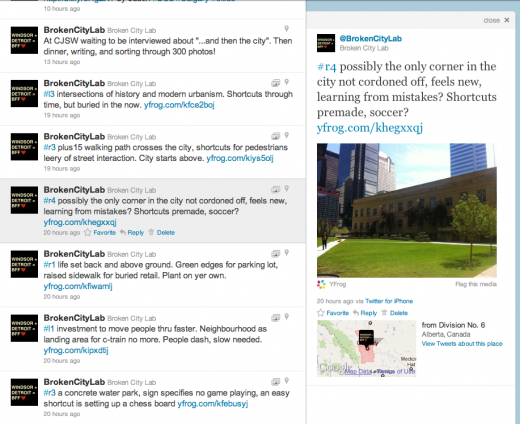




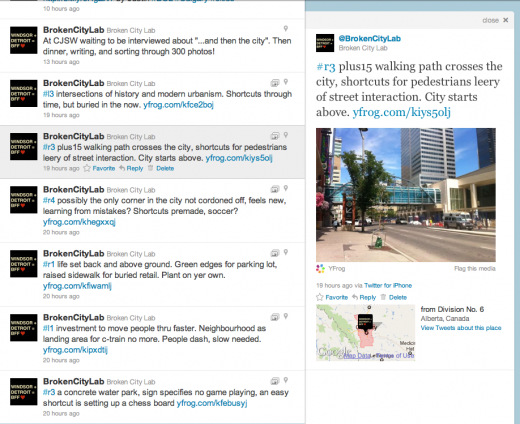

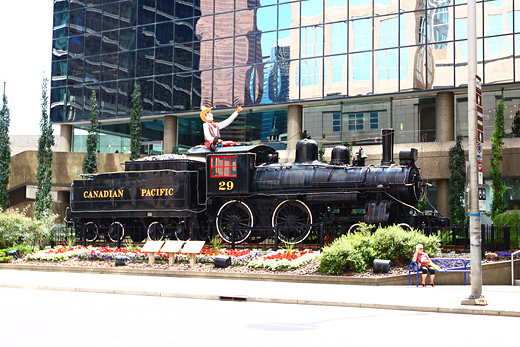
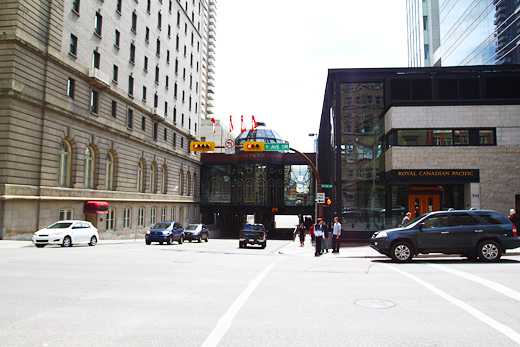
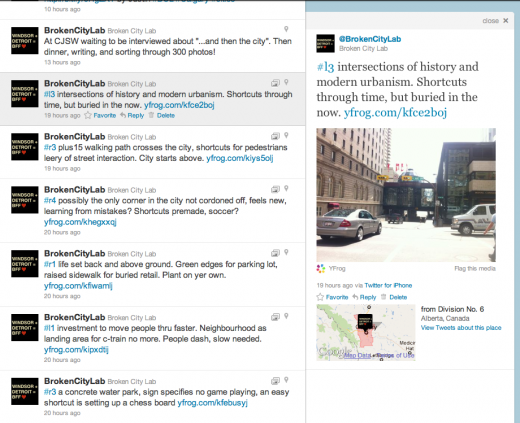
Very interesting juxtaposition or words, “Contemporary Art Mobile Exhibition Rig”.
The fortune teller algorithmic walk device is extremely interesting. I’ve never heard of such a thing, though it seems so obvious in a way. That can maybe be used later for something. It’s even a simple way to get school children on a derive of their own.
Great documentation.
Thanks a lot Stephen! The fortune teller device started as a stand-in for a computer-based algorithm, but became refreshing and fun.
Sorry we can’t make it to your opening. I hope to see some documentation eventually! Cheers.
This is inspiring. Not least bcuz it looks like summer. ‘Shortcuts for Urban Resistance & Algorithmic Walks’ – http://t.co/y0qat7w
Windsor’s pride and joy (@brokencitylab) is in Calgary for 10 days doing some KILLER-fun research about cities – Look! http://ow.ly/5KvZm
http://t.co/DZwv7Iv could be an icon for the size of the resistance in Calgary (from http://t.co/QdsQANG by @brokencitylab )